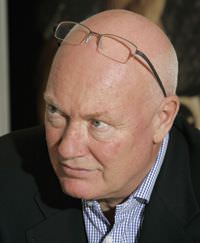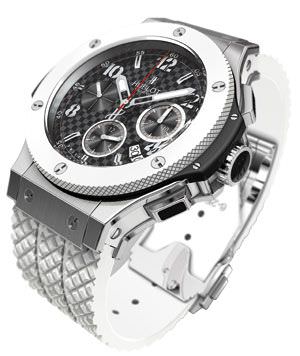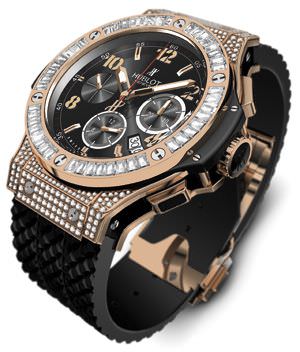
“The sun never sets on the world,” begins an animated Jean-Claude Biver, who himself never seems to ‘set’ either. “In a globalized planet, we cannot allow ourselves to sleep. We need to change our habits. As for me, I get up at 3 o’clock every day. This way, I can telephone Tokyo, where they are already working, or Los Angeles, where they are still working. When one is ‘small’ as we are at Hublot, there is only one way to make it when confronted with the mastodons that surround us, and that is to keep one step ahead. Success will only come if we work more than the others.”
This high level of reactivity and energy explain in large part Hublot’s surprising success since Biver took the reins in June of 2004, only 18 months ago (see Europa Star, January 2005). With the launch of his Big Bang at BaselWorld 2005, Biver succeeded in breathing new life into the brand founded by Carlo Croco. This very well designed, immediately recognizable, and highly identifiable watch (it won Best Design in Geneva’s 2005 Grand Prix de l'Horlogerie) is enjoying widespread appreciation from the world’s watch enthusiasts. At the same time, it is refreshing the profile of the brand’s clientele.
The success of the Big Bang has exceeded even Biver’s expectations. The demand is so great that the brand cannot keep up with supply. Today, it is hard to find one of these timepieces, except on ‘well managed’ waiting lists (and on this point, we can certainly trust Biver to manage them well). This is not a bad thing, however, as it offers a great advantage in terms of marketing. (You might recall there was the same phenom-enon when Panerai was launched.)

The codes of the epoch
The strength of the Big Bang is in the adoption of the codes of the epoch (affirmed lines, distinct sportiness, very large size (44.5 mm), creativity of materials (gold, steel, ceramic, tantalum, rubber, Kevlar…) while it has scrupulously, and strictly, respected Hublot’s fundamentals, as demonstrated in the graphics to the right, and its well known mix of materials.
In 1980, Carlo Croco made his mark by mixing gold and rubber for the first time. With the Big Bang, the initial ‘fusion’ becomes a driving concept, vigorously branded by Biver. By using a capital ‘F’, Fusion has also become the watchword of the brand. The Big Bang timepieces that will be presented at BaselWorld 2006 will push the concept even further, especially with the use of a material hitherto unknown in watchmaking. It has very surprising properties, along with difficulties in tooling, which we were able to get a glimpse of, but for now its name remains top secret.
“In its development, the Big Bang epitomizes the research into new materials and new technologies, such as, for example, the movements we are preparing that are made in titanium, aluminium, and black or white ceramic. The Big Bang immediately evokes the idea of Fusion that will also affect all of Hublot’s other product lines,” affirms Jean-Claude Biver. Far from the occultation that one might fear for Hublot’s more traditional products, the immediate acceptance of the Big Bang has actually had the opposite effect. It has ‘pulled’ the rest of the offer along, too. “There is a noticeable Big Bang positive effect on the sell-out of the other products of our collection,” Biver explains.
Beyond the sales due to the Big Bang effect, the traditional collection has been formally reworked in the same spirit. Cases have taken on a ‘robust’ look, in the materials, the colour and the size of the screws displayed on the crown, and new sizes are being proposed (44mm, 41mm). As Biver says, “The Big Bang has had a definite and dynamic effect on all the rest.”


The little black book
But, to be exact, we must state that the resounding success of the Big Bang is not due entirely to its design and its shape. One of the key reasons for this achievement can be found in Biver’s pocket. It is his little black book, a formidable repertoire of the addresses of the most important players in the watch business, names that he has collected around the world during three decades of work with Blancpain, then later as head of Omega. Still we must add that without the famous ‘concepts’ that are the driving force behind his actions, this address book would mean nothing. So just how was the Big Bang launched?
In general, the traditional way of thinking when it comes to planning product launches still holds sway. For Biver, this type of thinking, especially in light of globalization, is way out of date. “In September 2005, I launched the Big Bang, in an exclusive manner, around the planet,” he declares loudly and somewhat mischievously. Explaining this particular course of action, he adds “Rather than specific markets, I first chose 35 exclusive sales points (now there are 50) spread throughout the world. I favoured the best ‘handfuls’, if I might put it that way, which means those sales points that attract clients who are most in the media spotlight, most apt to wear the watch, and whose actions are the most emulated. In this way, we start off with a high quality ‘word of mouth’ promotion. When you are ‘small’, you have to be inventive. I don’t have the large advertising budgets of the large groups, and since I cannot impose myself with massive marketing efforts, I need to take a more creative approach, which means that we must be Concentrated, Consistent, Cohesive, and Continuous.”
The ‘4 Cs’
Another of Biver’s ideas, which he calls “the 4 C policy”, applies to the brand’s overall actions. “If you don’t have money but want to get yourself noticed, it is better to do one thing at a time,” he says. “We don’t spread ourselves around, neither in the media nor in distribution. We concentrate our visibility on only a few media and only a few sales points, with consistency and continuity, all in a cohesive manner (and with a few genuine tricks of the trade that we cannot reveal).”
The result of this activity, boldly conducted with “the same budget and a team of 35 people at the headquarters in Nyon, near Geneva, including six in the USA and four in Japan” has led to a tripling in sales, according to Biver.
This three-fold increase is not due to a quantitative augmentation, but rather to a very serious move up in positioning and in price. The entry level price of the steel Big Bang on the Swiss market is 9,200 Swiss francs. The average price of the traditional Hublot collection is 2,900 Swiss francs. “I got the client to accept this price increase because of the aspiration of the product,” he explains - and, of course, due to his hard work and that of the entire team.
At the beginning of January, in the halls at Hublot, the team was proud of what it had accomplished, even if the bodies were tired. Biver just announced, however, that “The holiday’s over.” We are still going to feel the effects of the Big Bang: Hublot is an expanding universe.
Source: February - March 2006 Issue




